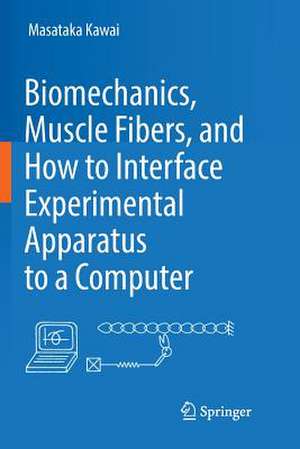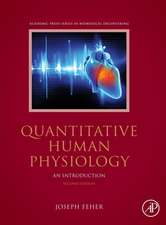Biomechanics, Muscle Fibers, and How to Interface Experimental Apparatus to a Computer
Autor Masataka Kawaien Limba Engleză Paperback – 6 iun 2019
| Toate formatele și edițiile | Preț | Express |
|---|---|---|
| Paperback (1) | 707.50 lei 6-8 săpt. | |
| Springer International Publishing – 6 iun 2019 | 707.50 lei 6-8 săpt. | |
| Hardback (1) | 714.27 lei 6-8 săpt. | |
| Springer International Publishing – 8 feb 2018 | 714.27 lei 6-8 săpt. |
Preț: 707.50 lei
Preț vechi: 744.73 lei
-5% Nou
Puncte Express: 1061
Preț estimativ în valută:
135.44€ • 139.37$ • 114.17£
135.44€ • 139.37$ • 114.17£
Carte tipărită la comandă
Livrare economică 01-15 martie
Preluare comenzi: 021 569.72.76
Specificații
ISBN-13: 9783319891323
ISBN-10: 3319891324
Pagini: 120
Ilustrații: XX, 120 p. 46 illus.
Dimensiuni: 155 x 235 mm
Greutate: 0.21 kg
Ediția:Softcover reprint of the original 1st ed. 2018
Editura: Springer International Publishing
Colecția Springer
Locul publicării:Cham, Switzerland
ISBN-10: 3319891324
Pagini: 120
Ilustrații: XX, 120 p. 46 illus.
Dimensiuni: 155 x 235 mm
Greutate: 0.21 kg
Ediția:Softcover reprint of the original 1st ed. 2018
Editura: Springer International Publishing
Colecția Springer
Locul publicării:Cham, Switzerland
Cuprins
Basic elements of viscoelasticity.- Reaction processes (chemical kinetics) and their application to muscle biology.- How to characterize chemical reactions occurring in muscle fibers?.- Structure and function of muscle cells.- Mathematics needed to solve problems of contraction.- Computer interfacing of experimental apparatus.- Appendices.
Notă biografică
Dr. Masataka Kawai (spelled 河合正隆in Japanese) received his B.A. from The University of Tokyo (Pure and Applied Sciences 東京大学教養学部基礎科学科), Ph.D. from Princeton University (Biology; Princeton, NJ, USA), attended Physiology Course at Marine Biological Laboratory (Woods Hole, MA, USA), and postdoctoral training at Colum-bia University (Muscle biology; New York City, USA), where he became a junior faculty member. He is now a professor of Anatomy and Cell Biology at The University of Iowa, College of Medicine, Iowa City, IA, USA. He has taught histology to medical and dental students for 35 years; he also taught principles of scholarly integrity to graduate and post-doctoral students. He has recently learned gross anatomy and teaches this subject. His hobbies include playing the piano, singing Japanese and Western lyrics, gardening, and travels.
Textul de pe ultima copertă
Back cover –Why this book?
This book covers a broad area of STEM (science, technology, engineering, and mathematics) disciplines, and is written for those interested in biophysics / biomechanics. It includes viscoelasticity, chemical kinetics, system analysis, muscle biology/biophysics and mechanics, analog and digital electronics, methods for interfacing experimental systems to a computer, and the mathematics needed for all of these. Only the bare essentials are given and many accessory elements are removed, so that it is easier to understand the concepts. Hence the book is brief and short. It is written so that a beginner can understand it, yet the principles can be applied to a variety of advanced systems. Special cases are handled, but readers should be able to apply them to their own projects and expand on them. This book also includes exercises for important theories and equations to be verified, and hints/answers to them are given at the end. If a theory or an equationis not apparent, readers are encouraged to prove them on their own, and convince themselves of their correctness. The equation may not be as difficult as it appears initially. Trying to solve a problem by oneself fosters good thinking, creativity, and independence.
Sections of this book were originally written for the purpose of teaching our experimental approaches and methods to new members of our laboratory. It is comprised of six chapters: chapter 1 defines viscoelasticity, chapter 2 describes chemical reactions, chapter 3 teaches how to characterize them, chapter 4 is their application on muscle biology, chapter 5 covers basic mathematical skills needed for these studies, and chapter 6 describes the electronic and computer interfacing of the experimental apparatus including programming. Chapters 1-5 are suitable for biophysically and mechanically oriented students. Chapters 5-6 are also suitable for electrical engineering and computer science students to acquire the basic concepts of electricity, a knowledge on analog and digital circuits, the interfacing of experimental apparatus to computers including programming. It is not necessary to read this book from the beginning, you can start from any chapter based on your interest and need.
In a sense, this book is similar to “case-based learning (CBL)”, which is a frequently used technique in today’s medical schools to teach students. A special patient case is brought out, and students are asked to organize their thoughts around it. By discussing the case with colleagues and researching the literature, the students set up hypotheses, think about the mechanisms and search for remedies. This book describes a special case and discusses it, but the lessons learned can be applied to numerous systems using similar methods and principles, and avoids generalization because that would make the theories abstract and more difficult to understand.
This book covers a broad area of STEM (science, technology, engineering, and mathematics) disciplines, and is written for those interested in biophysics / biomechanics. It includes viscoelasticity, chemical kinetics, system analysis, muscle biology/biophysics and mechanics, analog and digital electronics, methods for interfacing experimental systems to a computer, and the mathematics needed for all of these. Only the bare essentials are given and many accessory elements are removed, so that it is easier to understand the concepts. Hence the book is brief and short. It is written so that a beginner can understand it, yet the principles can be applied to a variety of advanced systems. Special cases are handled, but readers should be able to apply them to their own projects and expand on them. This book also includes exercises for important theories and equations to be verified, and hints/answers to them are given at the end. If a theory or an equationis not apparent, readers are encouraged to prove them on their own, and convince themselves of their correctness. The equation may not be as difficult as it appears initially. Trying to solve a problem by oneself fosters good thinking, creativity, and independence.
Sections of this book were originally written for the purpose of teaching our experimental approaches and methods to new members of our laboratory. It is comprised of six chapters: chapter 1 defines viscoelasticity, chapter 2 describes chemical reactions, chapter 3 teaches how to characterize them, chapter 4 is their application on muscle biology, chapter 5 covers basic mathematical skills needed for these studies, and chapter 6 describes the electronic and computer interfacing of the experimental apparatus including programming. Chapters 1-5 are suitable for biophysically and mechanically oriented students. Chapters 5-6 are also suitable for electrical engineering and computer science students to acquire the basic concepts of electricity, a knowledge on analog and digital circuits, the interfacing of experimental apparatus to computers including programming. It is not necessary to read this book from the beginning, you can start from any chapter based on your interest and need.
In a sense, this book is similar to “case-based learning (CBL)”, which is a frequently used technique in today’s medical schools to teach students. A special patient case is brought out, and students are asked to organize their thoughts around it. By discussing the case with colleagues and researching the literature, the students set up hypotheses, think about the mechanisms and search for remedies. This book describes a special case and discusses it, but the lessons learned can be applied to numerous systems using similar methods and principles, and avoids generalization because that would make the theories abstract and more difficult to understand.
Caracteristici
A step-by-step guide to aid the understanding of biomechanics Comprehensive account relating chemical reactions to observed parameters A comprehensive section of the basic mathematical solutions




























